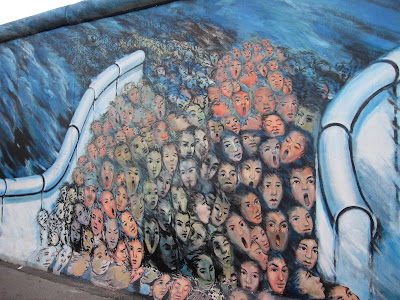Both tours went for about 3 hours and we visited some of the major sights during that time and heard a general history of Berlin, the world wars, the Cold War and particularly the rise and fall of the Nazis. As we walked through the city, we saw:
- The Reichstag (German Parliament building);
- The Brandenburg Gate, in which anyone coming to Berlin in the early years were required to enter through;
- A site where a remaining section of the Berlin Wall still stands and is also home to ‘Checkpoint Charlie’, the Soviet border crossing dividing East and West Berlin during 1961-1989 when the wall fell;
- The memorial to the Murdered Jews of Europe (Holocaust Memorial);
- The site of Hitler’s bunker where he also committed suicide. The site has purposely been left bare with no form of any memorial for obvious reasons;
- The last remaining Nazi building, which was once home to the Nazi Aviation Ministry. It is an extremely intimidating building with solid lines and granite materials used to stand the test of time;
- The book burning memorial, which commemorates the 1933 event where the Nazis burnt over 25,000 ‘un-German’ books and
- The Jewish Quarter including a major Synagogue and cemetery.






While I am definitely not a history writer and will therefore spare you from any lame historical descriptions of the places we visited (I’ll leave you to google them and read for yourself), I can tell you about the impact they had on us and how our interest in learning more about modern history has changed…..there is something different about visiting a place and being told the story then and there, rather than reading it from some history book in school. Maybe what we had learned as a teenager seemed abstract and more like a story, while being here and seeing where it all took place brought it to life and made it real.
The human devastation, hardship, torture and murder perpetrated by the Nazis was what disturbed us the most. We saw images and read stories, not only of the murdered Jews, but also gypsies, homosexuals and any other ‘outcast’ who was deemed ‘unfit for work’. We were shocked to learn that over 70,000 people who were mentally ill or physically/mentally disabled were also murdered in gas chambers. The Nazis labelled them ‘useless eaters’ or ‘life unworthy of life’ and justified their murder as ‘euthanasia’, using the propaganda of ‘putting them out of their misery’. The evil of what took place not only in Germany, but across Europe as the Nazis gained power, is literally sickening. I have never experienced instant nausea bordering on the urge to vomit until being exposed to these images and stories in the place where they occurred.
The experience was personalised for us when we visited the Jewish Museum and went inside what has been named the ‘Holocaust Tower’. We were there just before closing time and entered an iron door unaccompanied. We were instantly surrounded by four concrete walls at least 5 storeys high and in complete darkness besides a small ray of light strategically shining high in one corner. The iron door slammed shut behind us and sounded as if it was being latched which echoed off the walls. I instantly went into a panic inside and scrambled for the door to make sure it was still open. It was the feeling of fear and suffocation of those walls that made me want to get out of that nauseating enclosure immediately. Despite wanting to get out of there right away, we decided to stay and allow those feelings to be, without the need to escape them. Maybe that afternoon, we caught the tiniest glimpse of what it was like to experience the terror of living under the Nazi regime. It was a powerful exhibition to say the least.
Before Berlin, our biggest aim for travel was to experience food, wine and culture through meeting local people. Where we have previously been a bit uninterested with learning about some historical events, visiting museums or viewing pieces of architecture, we realise now that all of these are key pieces of the puzzle if we truly want to discover a culture. Sure, some of what we see and read may not always arouse our interest, but our experiences in Berlin have made us more open to learning and to appreciate the importance of history a little more.
Leaving Berlin after 6 days was difficult because we literally felt like we had only scratched the surface and there was so much more to discover. Unfortunately, the weather wasn't very kind to us and rained every day we were in Berlin which made squeezing things in a little difficult. It would have taken us another two weeks (at least) to visit the museums and other sights we were interested in, but we knew we had to move on, especially knowing there will be many more places we will have to tear ourselves away from. In particular, we were disappointed to have not visited the Sachsenhausen Concentration Camp, which was the first ‘model’ camp the Nazi’s implemented. We were mindful however that we were on our way to Krakow in Poland to visit the Auschwitz concentration camp, so we let it slide. All in all, we were thankful for what we had the opportunity to see and learn.

0 comments:
Post a Comment